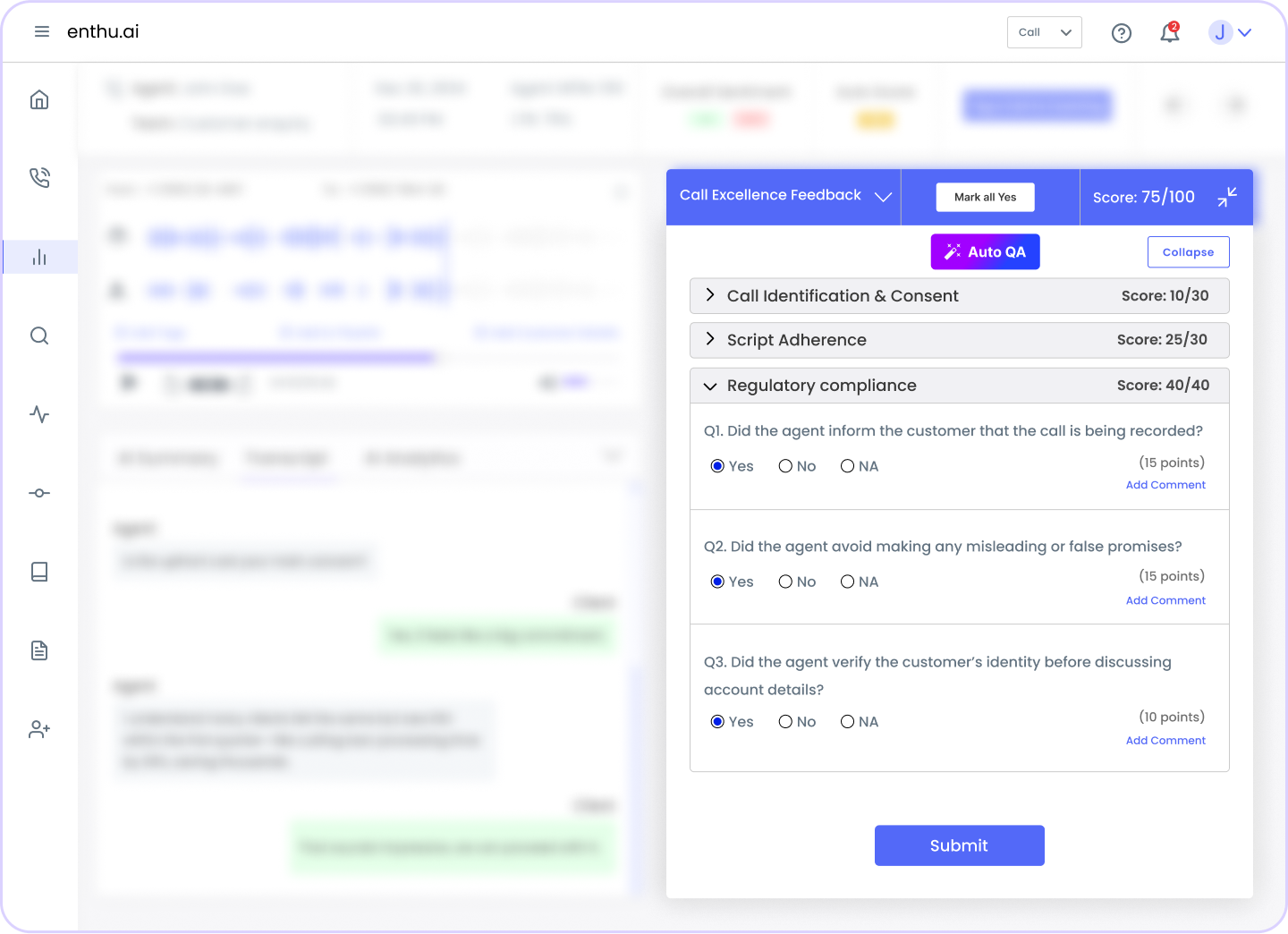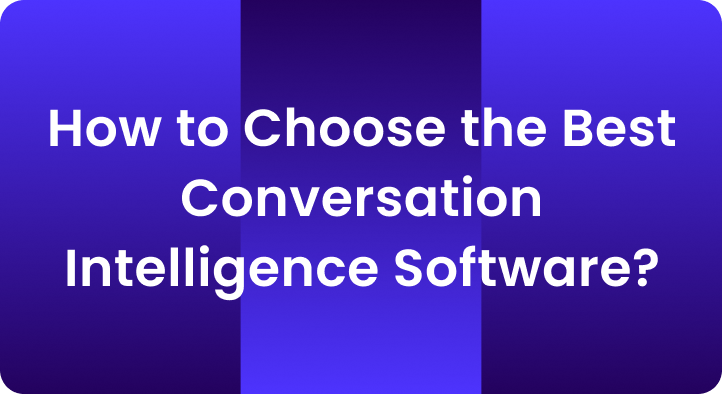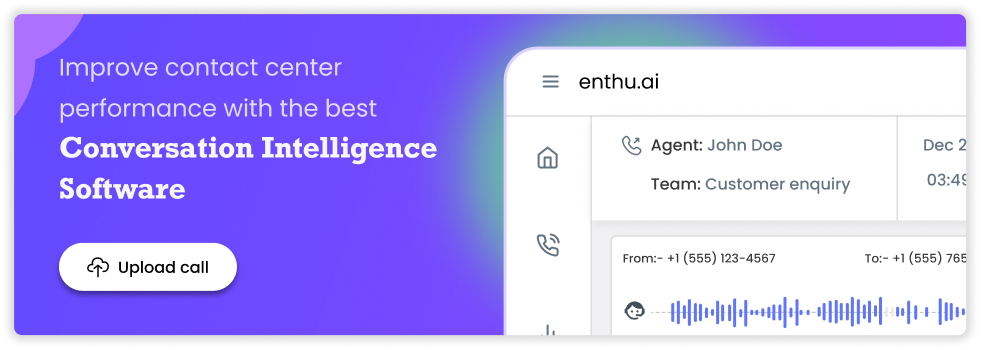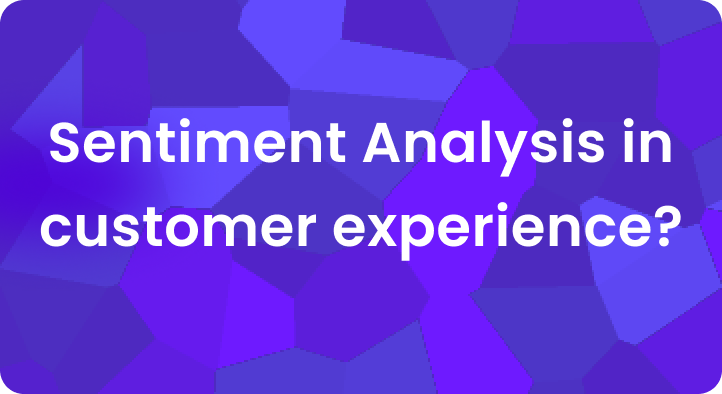Are your QA teams drowning in call reviews while missing critical customer insights?
You’re analyzing maybe 2-3% of calls manually, coaching is limited to top performers, and customer sentiment trends slip through unnoticed. Meanwhile, compliance risks lurk in unmonitored conversations.
This isn’t sustainable.
Conversation intelligence software changes everything. It records, transcribes, analyzes, and summarizes every customer interaction, voice and video using AI.
You’ll scale coaching, automate call quality assurance, capture voice of the customer insights, and boost both conversion rates and satisfaction scores.
This guide reveals exactly how to choose the right platform. You’ll discover the signs you’re ready, the critical evaluation criteria, and how to avoid expensive mistakes.
Ready to make every conversation count?
A. What is conversation intelligence software and why does it matter now?
Conversation intelligence software automatically captures conversations, builds accurate transcripts, spots patterns through natural language processing, and surfaces actionable insights that drive business decisions.
This goes far beyond traditional call recording. Legacy systems store audio files passively. Modern CI platforms apply machine learning to detect customer sentiment, identify compliance risks, measure talk ratios, and flag deal-killing objections in real time.
Core business outcomes include:
- Scale coaching and feedback – Analyze 100% of calls instead of random samples, identifying coaching moments across your entire team
- Automate QA and ensure compliance – Replace manual scorecards with AI-driven evaluations that maintain consistency and catch regulatory violations before they escalate
- Capture Voice of the Customer insights – Aggregate feedback across thousands of interactions to inform product development and CX strategy
- Improve conversion rates and satisfaction – Surface what top performers do differently, then replicate those behaviors across teams
B. Signs you’re ready for conversation intelligence
Your pain points signal it’s time for conversation intelligence software when manual processes can’t keep pace with growth.
Common indicators you’re ready:
- Coaching limited to top performers – Managers lack bandwidth to review calls from every rep, creating performance gaps
- Manual QA can’t scale – Your team evaluates 2-5% of calls while missing trends buried in the remaining 95%
- Sales managers lack pipeline visibility – Forecasts rely on rep intuition rather than objective conversation data
- Customer feedback stays scattered – Insights live in disconnected notes instead of structured, searchable databases
- Forecasting errors persist – Deal slippage happens because warning signs weren’t detected in buyer conversations
Ask yourself: Can your QA team audit every compliance-critical call? Do managers know which objections kill deals most often? If not, you’re leaving revenue and risk on the table.
C. Key evaluation criteria when choosing a CI tool
Choosing conversation intelligence software demands assessing nine critical factors that separate powerful platforms from glorified transcription tools.
1. Accuracy and insight quality
Transcription accuracy directly impacts trust and adoption rates across your organization.
Top platforms achieve 85-95% accuracy even with accents, background noise, and industry-specific terminology. But accuracy alone isn’t enough. The best systems detect speaker sentiment shifts, identify buyer intent beyond keywords, and contextualize conversations within your sales methodology or compliance framework.
Validate accuracy by testing with real calls from your environment. Upload recordings with varied audio quality, multiple speakers, and technical language to see how platforms handle crosstalk and jargon.
2. Integration with your tech stack
Poor integration breaks adoption faster than any feature gap.
Your conversation intelligence platform must connect natively with your CRM (Salesforce, HubSpot), dialers, learning management systems, and collaboration tools like Slack. Two-way sync ensures call data, conversation summaries, and QA scores flow into the tools your teams already use daily.
Centralized reporting aligns forecasting with QA insights, creating a single source of truth. Platforms that require manual data exports or lack API flexibility create friction that kills usage within months.

3. Coaching and performance features
Real-time and post-call coaching capabilities determine whether conversation intelligence becomes a performance multiplier or just another dashboard.
Look for AI-powered coaching insights that highlight talk ratios, filler word usage, and script adherence. Keyword triggers should alert managers to competitive mentions or pricing objections instantly.
The best platforms create playlists of exemplary calls for onboarding new reps and offer role-based dashboards tailored to reps, team leads, and executives.
4. Automated quality assurance & scorecards

Automating call quality assurance transforms QA from a bottleneck into a strategic advantage for contact centers.
AI-driven scoring evaluates 100% of conversations using customizable QA scorecards aligned with compliance requirements, empathy standards, and resolution protocols. This eliminates sampling bias and inconsistency that plague manual reviews.
Real-world impact:
- Teams reduce manual QA hours by 70% while improving coverage
- Contact centers identify top and bottom performers instantly using objective metrics
- QA data integrates with coaching dashboards, creating continuous improvement loops
Platforms like Enthu.AI specialize in contact center QA automation, applying AI agents to monitor compliance, score calls consistently, and surface training opportunities across every customer interaction.
5. Automation and scalability
Growth should strengthen your conversation intelligence system, not break it.
Evaluate batch processing capabilities, AI tagging workflows, and automated triggers that route high-risk calls to supervisors. Multi-language and multi-region support matters for distributed teams.
Cloud architectures scale seamlessly during peak loads, while on-premise options suit organizations with strict data residency requirements.
6. Data security and compliance
Security failures destroy customer trust and invite regulatory penalties that dwarf software costs.
Verify vendors maintain SOC 2, GDPR, and HIPAA compliance where applicable. Encryption should protect data in transit and at rest. Role-based permissions prevent unauthorized access to sensitive conversations.
Redaction controls automatically mask credit card numbers, social security digits, and protected health information from transcripts.
7. User experience and adoption
The most feature-rich platform fails if teams won’t use it consistently.
Onboarding speed matters. Can teams see value within days, not months? Simple UIs with minimal clicks and intuitive dashboards drive daily usage.
Responsive support and in-app guidance accelerate adoption across sales, QA, and CX departments.
8. Reporting and analytics

Unified reporting transforms conversation data into strategic decisions that executives actually act on.
Best-in-class platforms surface sentiment trends, talk ratio benchmarks, deal risk indicators, and keyword frequency analysis in real-time dashboards.
Reports should guide action, not just display data. Integration with business intelligence tools enables custom analyses tied to revenue metrics.
9. Pricing and ROI
Pricing models vary dramatically, from per-user subscriptions ($30-150/month) to usage-based tiers charged per minute or per call.
Calculate the total cost of ownership over 24 months, including implementation time and training overhead.
Then quantify ROI through time saved on QA, conversion rate improvements, and churn reduction. Document these metrics to secure leadership buy-in.
D. How to compare vendors and avoid common mistakes?
A structured comparison framework prevents costly missteps when evaluating conversation intelligence vendors.
Shortlist systematically by:
- Feature match – Do core capabilities align with your must-haves (QA automation, real-time alerts, CRM sync)?
- Integration fit – Will the platform work with your existing telephony, CRM, and analytics stack?
- Scalability – Can it handle your call volume today and 3X growth in two years?
- Support quality – What do current customers say about implementation help and ongoing responsiveness?
Common mistakes to avoid:
- Prioritizing flashy features over core usability and transcription accuracy
- Ignoring data privacy requirements until legal blocks deployment
- Overlooking onboarding support, leaving teams struggling with adoption
Run effective pilots by using real calls from your environment, defining clear success metrics (accuracy rate, time saved, insights actioned), and gathering feedback from both reps and managers before committing to enterprise contracts.
E. Must-have vs. nice-to-have features
Prioritizing features based on team goals prevents overpaying for capabilities you won’t use while ensuring you don’t miss critical functionality.
| Feature Category | Must-Have | Nice-to-Have |
| Transcription | 90%+ accuracy, speaker identification | Multi-language support, custom vocabulary |
| Integrations | Native CRM sync (Salesforce, HubSpot), dialer connection | Learning management system, BI tools |
| QA & Compliance | Automated scorecards, compliance alerts, and call scoring | Emotion detection, competitor tracking |
| Coaching | Performance dashboards, call libraries, keyword triggers | Video call analysis, real-time prompts |
| Analytics | Sentiment analysis, talk ratios, trend reporting | Predictive deal scoring, churn risk models |
Prioritization guidance:
- Sales performance focus – Prioritize deal intelligence, CRM integration, and coaching workflows
- Customer experience focus – Emphasize sentiment analysis, voice of the customer analytics, and CSAT correlation
- Compliance focus – Demand automated QA scorecards, redaction controls, and audit trails
F. How to ensure company-wide adoption?
Technology investments fail when teams don’t embed them into daily workflows, making the adoption strategy as critical as vendor selection.
Align sales, CX, and QA teams around shared KPIs tied to conversation intelligence insights. Establish internal champions who demonstrate value and troubleshoot resistance. Track adoption metrics, including active users, percentage of calls analyzed, and coaching feedback delivered weekly.
Training best practices:
- Conduct role-specific onboarding (reps need different skills than QA analysts)
- Create internal libraries of best calls tagged by use case
- Incentivize data-driven coaching through manager performance reviews
G. Vendor comparison: Enthu.AI vs. leading CI platforms
Understanding how Enthu.AI compares to established conversation intelligence vendors helps you match capabilities to your specific contact center and sales requirements.
| Feature | Enthu.AI | Gong | Chorus | Observe.ai |
| Primary Focus | Contact center QA automation + real-time assistance | Enterprise sales forecasting | Sales coaching | Contact center compliance |
| Transcription Accuracy | 90%+ with industry terms | 85-95% | 85-90% | 90%+ |
| Automated QA Scorecards | Customizable, AI-driven | Limited | Limited | Strong |
| Real-Time Coaching | AI agents provide live assistance | Post-call only | Basic | Advanced |
| CRM Integration | Salesforce, HubSpot, custom APIs | Salesforce, HubSpot | Salesforce, Zoom | Salesforce, Zendesk |
| Sentiment Analysis | Voice of customer analytics | Deal-focused | Basic | Support-focused |
| Compliance Tools | SOC 2, redaction, audit logs | Enterprise-grade | Basic | HIPAA, PCI |
| Pricing Model | Custom enterprise | $100+/user/month | $500-2000/month | Custom enterprise |
| Best For | Contact centers needing QA automation + sales teams wanting real-time help | Large enterprise sales teams | Mid-market sales coaching | Regulated contact centers |
Enthu.AI’s agentic AI architecture automates contact center workflows from QA to CSAT analysis to real-time agent assistance, making it ideal for organizations prioritizing call quality monitoring software and customer sentiment analysis.
Conclusion
Choosing conversation intelligence software transforms how your organization coaches teams, ensures quality, and captures customer insights at scale.
The right platform delivers 90%+ transcription accuracy, automates call quality assurance through customizable QA scorecards, integrates seamlessly with your CRM, and surfaces the voice of the customer analytics that drive strategic decisions.
Vendors like Enthu.AI combine contact center QA automation with real-time AI assistance, reducing manual review time by 70% while improving compliance and customer satisfaction.
Ready to automate your contact center workflows and capture insights from every conversation? Explore how Enthu.AI’s intelligent AI agents transform QA, CSAT analysis, and real-time assistance at enthu.ai.
FAQs
1. What's the difference between conversation intelligence and call recording software?
Call recording passively stores audio files while conversation intelligence actively transcribes, analyzes sentiment, detects keywords, and surfaces actionable insights using AI and natural language processing. Intelligence platforms automate QA scorecards and coaching workflows that recording tools can’t deliver.
2. How accurate is AI transcription in conversation intelligence platforms?
Top platforms achieve 85-95% transcription accuracy in real-world conditions with accents, background noise, and industry terminology. Accuracy improves with speaker identification, custom vocabulary training, and audio quality optimization. Always test with your actual call recordings during pilots.
3. Can conversation intelligence software integrate with my existing CRM?
Yes, leading platforms offer native two-way integrations with Salesforce, HubSpot, Pipedrive, and other CRMs. Quality integrations automatically sync call data, conversation summaries, sentiment scores, and QA results into contact records without manual exports.




 On this page
On this page

